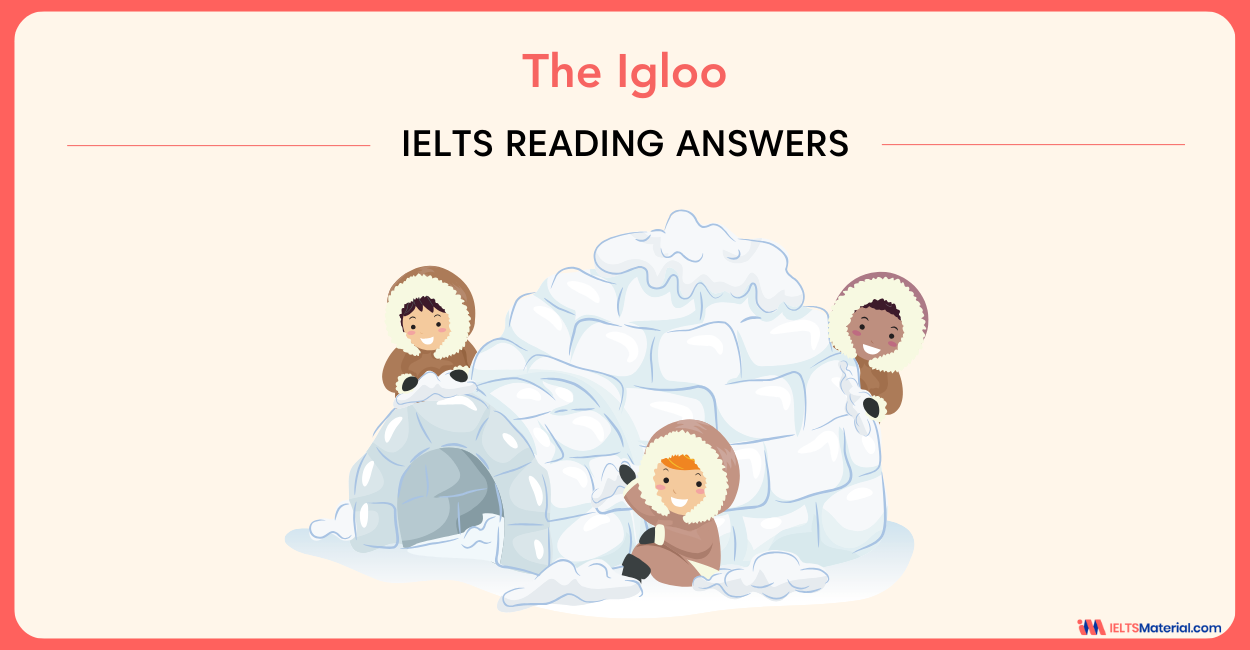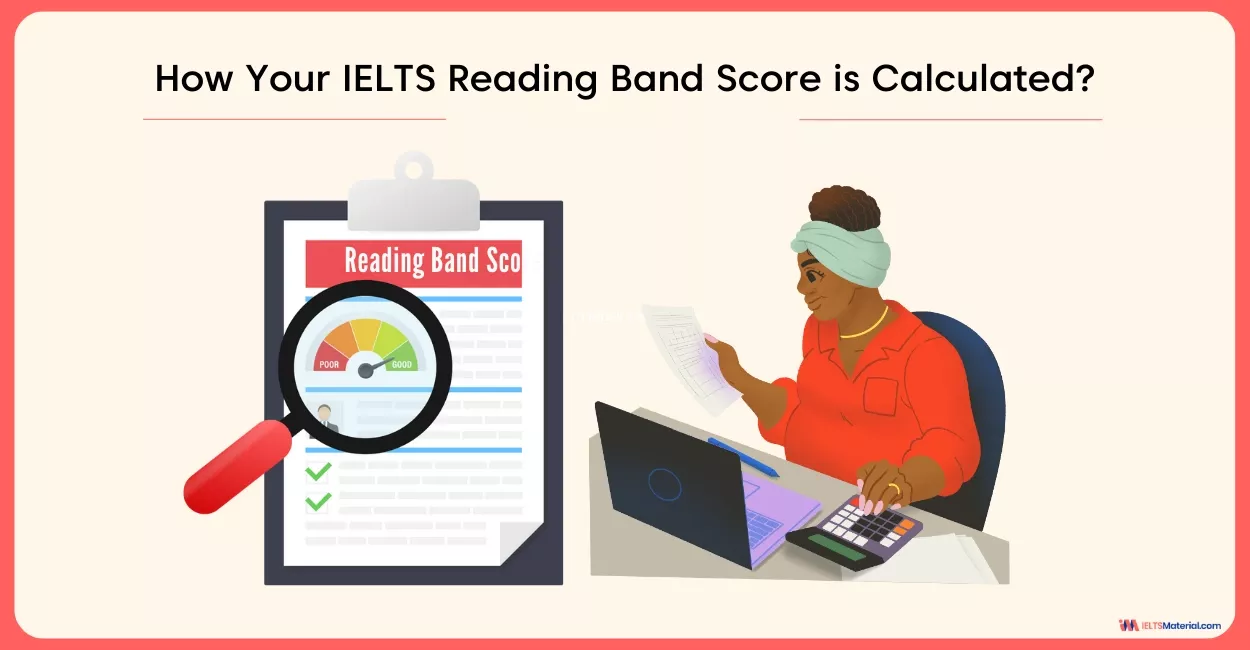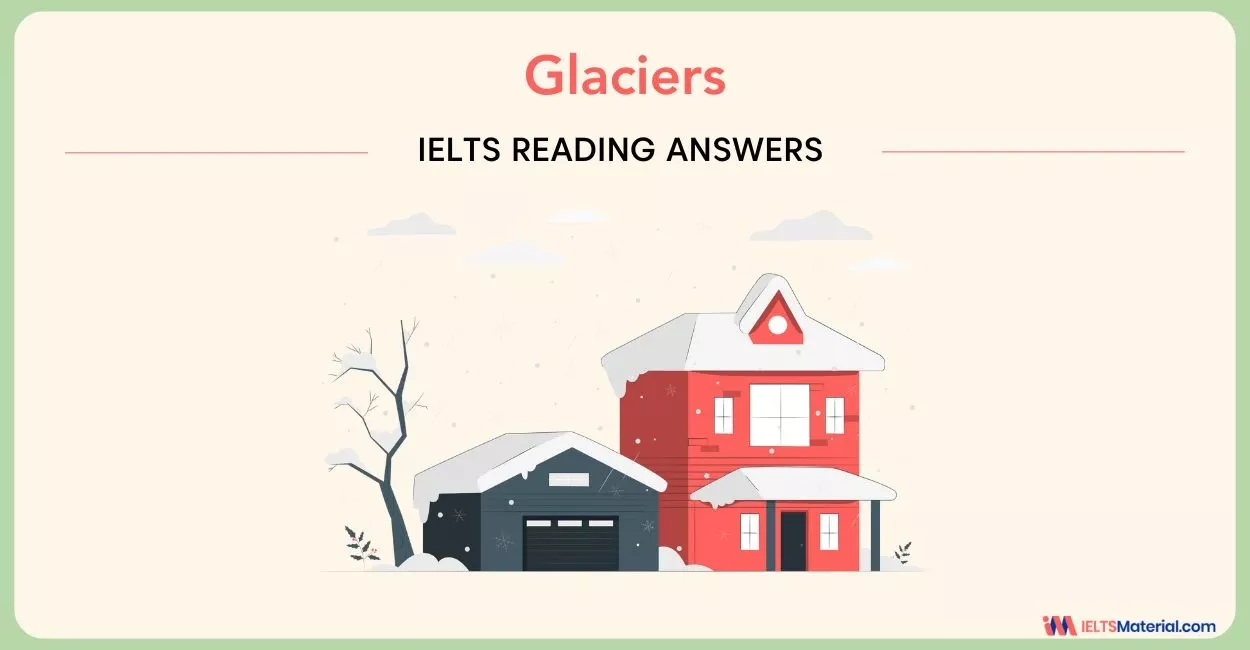Glaciers - IELTS Reading Answers
13 min read
Updated On
-
Copy link
Glaciers Reading Answers is an IELTS Academic Reading topic with 15 IELTS Reading questions, covering matching questions and True/False/Not Given. Take the test and tally your answers with the given explanations to prepare better for a band score of 9.
Table of Contents

Recent IELTS Reading Tests with Answers PDF
Glaciers Reading Answers covers various aspects such as glacier formation, their movement, impact on the environment, and historical significance. Candidates have to solve this reading passage in just 20 minutes, making effective time management in IELTS Reading crucial.
Practising passages like Glaciers IELTS Reading Answers ensure that you are able to master time management and attempt all questions within the given timeframe to achieve a reading band score of 9. Here, we will guide you to solve the IELTS Reading practice test, provide explanations with locations for the answers and provide tips on how to approach IELTS Reading with optimal time management strategies. Let’s get started!
Reading Passage for Glaciers Reading Answers
Go through the Glaciers Reading Answers passage given below using the reading techniques and understand how to get more correct answers for a high IELTS band score!
You should spend about 20 minutes on Questions 1-15, which are based on the Reading Passage below.
Glaciers
A Besides the earth’s oceans, glacier ice is the largest source of water on earth. A glacier is a massive stream or sheet of ice that moves underneath itself under the influence of gravity. Some glaciers travel down mountains or valleys, while others spread across a large expanse of land. Heavily glaciated regions such as Greenland and Antarctica are called continental glaciers. These two ice sheets encompass more than 95 percent of the earth’s glacial ice. The Greenland ice sheet is almost 10,000 feet thick in some areas, and the weight of this glacier is so heavy that much of the region has been depressed below sea level. Smaller glaciers that occur at higher elevations are called alpine or valley glaciers. Another way of classifying glaciers is in terms of their internal temperature. In temperate glaciers, the ice within the glacier is near its melting point. Polar glaciers, in contrast, always maintain temperatures far below melting.
B The majority of the earth’s glaciers are located near the poles, though glaciers exist on all continents, including Africa and Oceania. The reason glaciers are generally formed in high alpine regions is that they require cold temperatures throughout the year. In these areas where there is little opportunity for summer ablation (loss of mass), snow changes to compacted fim and then crystallized ice. During periods in which melting and evaporation exceed the amount of snowfall, glaciers will retreat rather than progress. While glaciers rely heavily on snowfall, other climactic conditions including freezing rain, avalanches, and wind, contribute to their growth. One year of below-average precipitation can stunt the growth of a glacier tremendously. With the rare exception of surging glaciers, a common glacier flows about 10 inches per day in the summer and 5 inches per day in the winter. The fastest glacial surge on record occurred in 1953 when the Kutiah Glacier in Pakistan grew more than 12 kilometers in three months.
C The weight and pressure of ice accumulation cause glacier movement. Glaciers move out from under themselves, via plastic deformation and basal slippage. First, the internal flow of ice crystals begins to spread outward and downward from the thickened snow pack also known as the zone of accumulation. Next, the ice along the ground surface begins to slip in the same direction. Seasonal thawing at the base of the glacier helps to facilitate this slippage. The middle of a glacier moves faster than the sides and bottom because there is no rock to cause friction. The upper part of a glacier rides on the ice below. As a glacier moves it carves out a U-shaped valley similar to a riverbed, but with much steeper walls and a flatter bottom.
D Besides the extraordinary rivers of ice, glacial erosion creates other unique physical features in the landscape such as horns, fjords, hanging valleys, and cirques. Most of these landforms do not become visible until after a glacier has receded. Many are created by moraines, which occur at the sides and front of a glacier. Moraines are formed when material is picked up along the way and deposited in a new location. When many alpine glaciers occur on the same mountain, these moraines can create a horn. The Matterhorn, in the Swiss Alps, is one of the most famous horns. Fjords, which are very common in Norway, are coastal valleys that fill with ocean water during a glacial retreat. Hanging valleys occur when two or more glacial valleys intersect at varying elevations. It is common for waterfalls to connect the higher and lower hanging valleys, such as in Yosemite National Park. A cirque is a large bowl-shaped valley that forms at the front of a glacier. Cirques often have a lip on their downslope that is deep enough to hold small lakes when the ice melts away.
E Glacier movement and shape-shifting typically occur over hundreds of years. While presently about 10 percent of the earth’s land is covered with glaciers, it is believed that during the last Ice Age glaciers covered approximately 32 percent of the earth’s surface. In the past century, most glaciers have been retreating rather than flowing forward. It is unknown whether this glacial activity is due to human impact or natural causes, but by studying glacier movement, and comparing climate and agricultural profiles over hundreds of years, glaciologists can begin to understand environmental issues such as global warming.
Glaciers Reading Answers Questions
There are three types of IELTS Reading question types in Glaciers Reading Answers. They are:
Now set your timer and complete these questions within the time limit!
Questions 1-5
Reading Passage 1 has five paragraphs, A-E. Choose the most suitable heading for each paragraph from the list of headings below.
Write the appropriate numbers (i-viii) on your Answer Sheet
There are more headings than paragraphs, so you will not use them all.
1 Paragraph A
2 Paragraph B
3 Paragraph C
4 Paragraph D
5 Paragraph E
List of Headings
i Glacial Continents
ii Formation and Growth of Glaciers
iii Glacial Movement
iv Glaciers in the Last Ice Age
v Glaciers Through the Years
vi Types of Glaciers
vii Glacial Effects on Landscape
viii Glaciers in National Parks
Questions 6-10
Do the following statements agree with the information in Passage 1 ? in boxes 6-10 on your Answer Sheet, write
TRUE if the statement is true according to the passage.
FALSE if the statement contradicts the passage.
NOT GIVEN if there is no information about this in the passage.
6 Glaciers exist only near the north and south poles.
7 Glaciers are formed by a combination of snow and other weather conditions.
8 Glaciers normally move at a rate of about 5 to 10 inches a day.
9 All parts of the glacier move at the same speed.
10 During the last Ice Age, average temperatures were much lower than they are now.
Questions 11-15
Match each definition below with the term it defines.
Write the letter of the term, A-H, on your Answer Sheet
There are more terms than definitions, so you will not use them all
|
Terms |
|
|
A |
fjord |
| B |
alpine glacier |
|
C |
horn |
|
D |
polar glacier |
|
E |
temperate glacier |
|
F |
hanging valley |
|
G |
cirque |
|
H |
surging glacier |
11 a glacier formed on a mountain
12 a glacier with temperatures well below freezing
13 a glacier that moves very quickly
14 a glacial valley formed near the ocean
15 a glacial valley that looks like a bowl
Want to learn tips on time management from IELTS Experts? Book a free demo today!
Glaciers Reading Answers with Location and Explanation
Tally your answers of the IELTS Academic Reading passage, Glaciers Reading Answers, with the answer key given below. Each answer is followed by its corresponding location in the passage and explanation for easy review.
1 Answer: vi
Question type: Matching Headings
Answer location: Paragraph A, line 4
Answer explanation: Few lines in the said paragraph indicate that “heavily glaciated regions such as Greenland and Antarctica are called continental glaciers. Smaller glaciers that occur at higher elevations are called alpine or valley glaciers. Also, in temperate glaciers, the ice within the glacier is near its melting point. Polar glaciers, in contrast, always maintain temperatures far below melting.” Hence, from this information, we can deduce that a comprehensive description of various glaciers is given.
Question type: Matching Headings
Answer location: Paragraph B, line 2
Answer explanation: Paragraph B brings forth the information that, “the reason glaciers are generally formed in high alpine regions is that they require cold temperatures throughout the year. In these areas where there is little opportunity for summer ablation (loss of mass), snow changes to compacted fim and then crystallized ice. Additionally, “while glaciers rely heavily on snowfall, other climatic conditions including freezing rain, avalanches, and wind, contribute to their growth.” Here, the formation and growth of glaciers are described in detail.
Question type: Matching Headings
Answer location: Paragraph C, line 6
Answer explanation: If you read through, a line provides the information that “the middle of a glacier moves faster than the sides and bottom because there is no rock to cause friction. The upper part of a glacier rides on the ice below. As a glacier moves it carves out a U-shaped valley similar to a riverbed, but with much steeper walls and a flatter bottom.” Hence, from this information, we can conclude that this paragraph gives an in-depth view of how glaciers move.
Question type: Matching Headings
Answer location: Paragraph D, line 1
Answer explanation: If you read thoroughly, there’s a line that claims, “besides the extraordinary rivers of ice, glacial erosion creates other unique physical features in the landscape such as horns, fjords, hanging valleys, and cirques.” Here, it is suggested that glaciers have a huge impact on the landscape they affect.
Question type: Matching Headings
Answer location: Paragraph E, line 2
Answer explanation: A line in the said paragraph suggests that “while presently about 10 percent of the earth’s land is covered with glaciers, it is believed that during the last Ice Age glaciers covered approximately 32 percent of the earth’s surface. Also, by studying glacier movement, and comparing climate and agricultural profiles over hundreds of years, glaciologists can begin to understand environmental issues such as global warming.” Hence, we can deduce that this paragraph gives us an idea about glaciers in various periods of time, not just the Ice Age.
Question type: True/False/Not Given Questions
Answer location: Paragraph B, line 1
Answer explanation: If you read through, there is a line in the said paragraph that suggests, “the majority of the earth’s glaciers are located near the poles, though glaciers exist on all continents, including Africa and Oceania. The reason glaciers are generally formed in high alpine regions is that they require cold temperatures throughout the year.” Since it’s mentioned that the ‘majority of the glaciers are located near the poles’ we can infer that not all glaciers are located near the poles. Hence, it is opposite to the claim made in the question.
Question type: True/False/Not Given Questions
Answer location: Paragraph B, line 2
Answer explanation: In the said paragraph it is mentioned that “the reason glaciers are generally formed in high alpine regions is that they require cold temperatures throughout the year. In these areas where there is little opportunity for summer ablation (loss of mass), snow changes to compacted finm and then crystallized ice.” Hence, from this line, we can learn that the process of glacier formation requires favorable weather conditions and snow.
8 Answer: TRUE
Question type: True/False/Not Given Questions
Answer location: Paragraph B, 2nd last line
Answer explanation: We can confirm that Glaciers move about 5 t0 10 inches a day from the information where the author says that “with the rare exception of surging glaciers, a common glacier flows about 10 inches per day in the summer and 5 inches per day in the winter.”
9 Answer: FALSE
Question type: True/False/Not Given Questions
Answer location: Paragraph C, line 4
Answer explanation: According to a line “the middle of a glacier moves faster than the sides and bottom because there is no rock to cause friction.” From this information, we can learn that all the parts of the glaciers do not move at the same speed because it is mentioned that the middle part of a glacier travels faster than the other parts.
10 Answer: NOT GIVEN
Question type: True/False/Not Given Questions
Answer location: Paragraph E, line 2
Answer explanation: If you read through, a line claims that “while presently about 10 percent of the earth’s land is covered with glaciers, it is believed that during the last Ice Age glaciers covered approximately 32 percent of the earth’s surface.” Here, it is mentioned that during the Last Ice Age glaciers used to cover larger territories. However, it does not state that the temperatures were lower.
11 Answer: B
Question type: Matching Information Questions
Answer location: Paragraph A, line 7
Answer explanation: If you observe clearly, you can point out that a line infers that “smaller glaciers that occur at higher elevations are called alpine or valley glaciers.” Hence, a glacier formed at the higher elevations (mountains) is known as an alpine glacier.
12 Answer: D
Question type: Matching Information Questions
Answer location: Paragraph A, line
Answer explanation: In the said paragraph, you can refer to “polar glaciers, in contrast, always maintain temperatures far below melting.” The term freezing point means the temperature at which a liquid turns into a solid when cooled whereas the term melting point means the temperature at which a given solid will melt. Theoretically, their temperatures are one and the same. Hence, “far below melting” has been paraphrased to “well below freezing”. Hence, we can deduce that polar glaciers have temperatures well below freezing.
13 Answer: H
Question type: Matching Information Questions
Answer location: Paragraph B, 2nd last line
Answer explanation: A-line states that “with the rare exception of surging glaciers, a common glacier flows about 10 inches per day in the summer and 5 inches per day in the winter. The fastest glacial surge on record occurred in 1953 when the Kutiah Glacier in Pakistan grew more than 12 kilometers in three months.” Since surging glaciers move fast, we can deduce that it is the fastest moving glacier.
14 Answer: A
Question type: Matching Information Questions
Answer location: Paragraph D, line 5
Answer explanation: Paragraph D puts forward the information that “Fjords, which are very common in Norway, are coastal valleys that fill with ocean water during a glacial retreat.” This line suggests that it is the Fjord glacier that is formed near the ocean.
15 Answer: G
Question type: Matching Information Questions
Answer location: Paragraph D, last line
Answer explanation: If you observe, a line claims that “a cirque is a large bowl-shaped valley that forms at the front of a glacier. Cirques often have a lip on their downslope that is deep enough to hold small lakes when the ice melts away.” Here, the answer is given when it is said that a cirque is a large bowl-shaped valley.
Tips for Answering the Question Types in Glaciers Reading Answers
Have a look at the IELTS Reading tips and techniques for each question type in Glaciers IELTS Reading Answers that will help you to solve similar questions.
Tips for Matching Headings (Questions 1-5)
- Focus on the first and last sentences of each paragraph, as they often introduce and summarize the main idea.
- Look for synonyms in the list of headings. The passage may use different words to express the same idea. For example, "Types of Glaciers" (vi) corresponds to Paragraph A, which describes continental and alpine glaciers.
- Identify key contrasts in paragraphs. If a paragraph discusses changes over time, it likely relates to a heading like "Glaciers Through the Years" (v).
- Paragraph D mentions specific landforms created by glaciers. This means the correct heading will relate to landscape changes, which matches "Glacial Effects on Landscape" (vii).
- Eliminate distractors. Some headings may seem correct at first glance but do not fully match the paragraph’s focus. For example, "Glaciers in National Parks" (viii) is too specific and does not apply.
Tips for True/False/Not Given (Questions 6-10)
- Locate keywords quickly and scan for synonyms. If the statement is about glacier locations, look for "all continents" or "poles" in the passage.
- Be cautious of extreme words like "only," "always," or "never." Statement 6 says "Glaciers exist only near the north and south poles." Since the passage states they exist on all continents, the correct answer is FALSE.
- For numerical details, find exact figures in the text. Statement 8 claims glaciers move 5 to 10 inches per day. The passage confirms this, so the answer is TRUE.
- Check for contradictions in the passage. Statement 9 says "All parts of the glacier move at the same speed," but the passage says the middle moves faster. So, the answer is FALSE.
- If you cannot find any reference to the statement, choose NOT GIVEN. Statement 10 talks about Ice Age temperatures, but the passage does not mention specific temperature differences, so the answer is NOT GIVEN.
Tips for Matching Definitions (Questions 11-15)
- Look for direct definitions in the text. For example, the passage says, "Smaller glaciers that occur at higher elevations are called alpine glaciers," which matches Question 11.
- Use the process of elimination. If you are unsure about a term, identify the ones you are certain about first. For example, "fjord" is mentioned as a coastal valley filled with water, making it the answer for Question 14.
- Match key phrases. "Well below freezing" in Question 12 corresponds to "always maintain temperatures far below melting," which describes polar glaciers (D).
- For speed-related questions, find movement terms. The fastest glacier movement is described under surging glaciers (H), making it the answer to Question 13.
- Use shape descriptions. "Bowl-shaped valley" in Question 15 is directly linked to "cirque," making the answer G.
To sum up, make sure to practice IELTS Reading recent actual tests, like Glaciers - IELTS Reading Answers. They play a crucial role in IELTS Reading preparation and a disciplined practice routine of these tests can lead to a significant boost in band score.
Check More IELTS Reading Answers
- Roman shipbuilding and Navigation IELTS Reading Answers
- Irish Potato Famine Reading Answers
- It's Eco-logical Reading Answers
- Obtaining Linguistic Data Answers
- Odonata Reading Answers
- William Gilbert And Magnetism Answers
- Indoor Pollution Reading Answers
- Micro Enterprise Credit For Street Youth Answers
Practice IELTS Reading based on question types

Start Preparing for IELTS: Get Your 10-Day Study Plan Today!
Explore other Reading Topics

Kasturika Samanta

Kasturika Samanta

Kasturika Samanta

Kasturika Samanta
Recent Articles

Nehasri Ravishenbagam

Haniya Yashfeen

Haniya Yashfeen

Haniya Yashfeen




Post your Comments